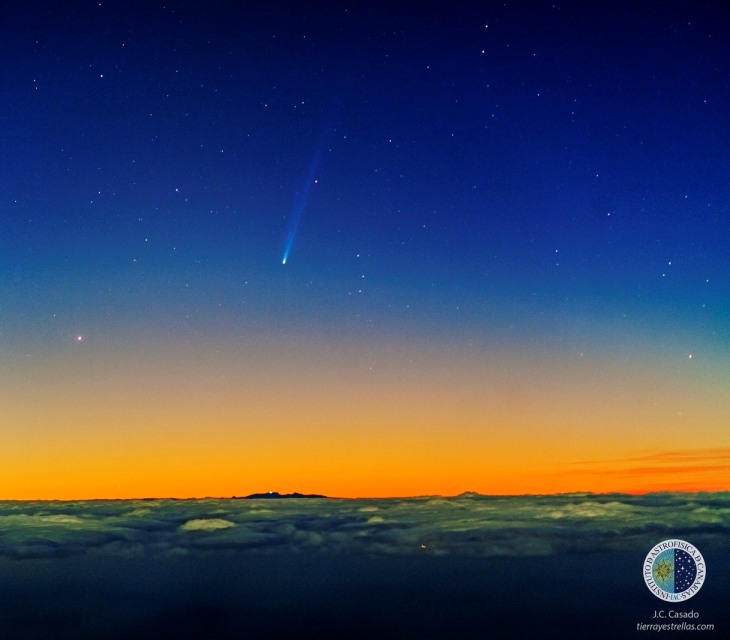SOLAR FLEET PICKS UP COMET ISON:
by Dr. Tony Phillips.
Because NASA's twin STEREO probes are designed to observe the sun, they
can see sundiving comets even when the glare becomes intense.
Yesterday, Comet ISON joined Earth, Mercury, and Comet Encke in the
field of view of STEREO-A's Heliospheric Imager. Click on the image to
view ISON's grand entrance:
"The
dark 'clouds' of stuff you see coming from the right are density
enhancements in the solar wind, and these are what are causing all the
ripples you see in comet Encke's tail,"
explains Karl Battams
of NASA's Comet ISON Observing Campaign. "I can pretty much promise you
that we're going to see ISON's tail doing that in a couple of day's
time, but on a much larger scale!"
Battams points out another
exciting development: Comet Encke and Comet ISON are converging for a
photogenic close encounter. "No they're not going to hit each other - in
reality they are millions of miles apart - but as seen from the
STEREO-A spacecraft, they are going to get very close!" he says. "We are
probably a couple of days away from seeing two comets almost
side-by-side in that camera, with long tails flowing behind them in the
solar wind. To say that such an image will be unprecedented is rather an
understatement."
Stay tuned for
that.
..........
Skywatchers excited as Comet ISON approaches its big day in the sun
Alan Boyle, Science Editor NBC News

J.C. Casado / GLORIA Project via Twitter
Comet
ISON (center) and Mercury (lower left) shine in the skies over the
Canary Islands' Tiede Observatory in a photo captured at dawn on Nov.
21-22 by Juan Carlos Casado through the Instituto de Astrofisica de
Canarias' GLORIA Project.
As Comet ISON approaches its climactic
Thanksgiving swing around the sun, astronomers are getting increasingly
excited about the prospects for a memorable show when it comes around
the other side.
"It's looking pretty wonderful, to be honest," Naval Research Laboratory astrophysicist Karl Battams, who's part of the
NASA Comet ISON Observing Campaign, told NBC News. "It's behaving in terms of its brightness pretty much how we thought it would
back in February."
Comet ISON has been sparking stellar expectations ever since its
discovery by Russian astronomers in September 2012.
But unlike some comet fans, Battams has shied away from predicting it
would turn into the "comet of the century." Instead, he favors the
saying attributed to veteran comet hunter David Levy: "Comets are like
cats; they have tails, and they do precisely what they want."
So far, Comet ISON appears to be doing what Battams and his colleagues want: It's hanging together, and
not breaking up as feared.
Fresh imagery from NASA's STEREO-A probe shows the comet in one piece — with Comet Encke's tail waving in the solar wind as it approaches its own close encounter.
"There are some really, really nice tail dynamics going on," Battams said.
Even as he gushes over the latest
pictures, Battams is keeping that catlike unpredictability of comets in
mind — particularly considering that ISON is due to come within only
700,000 miles (1.1 million kilometers) of the sun on Nov. 28. "My
opinion this morning is, I'm starting to feel like it's going to
survive," Battams said on Friday. "It might actually make it."
If ISON does survive, "I'm feeling comfortable saying that we're going to have a nice night-sky object in December," he said.
How nice? "It was never going to be the 'comet of the century,'" Battams said. "It'd have to be pretty good to out-comet
Comet McNaught."
Comet Lovejoy (formally designated C/2011 W3), which
wowed Southern Hemisphere observers in 2011, might be a "good analog" if ISON lives up to Battams' expectations. "It's an educated guess," he said.
ISON
is on the verge of being too close to the sun for casual observers to
make out in dawn's skies, but seasoned skywatchers are still getting
some good shots, as evidenced by the pictures submitted to
SpaceWeather.com's comet gallery.
Read More Here
.........




















